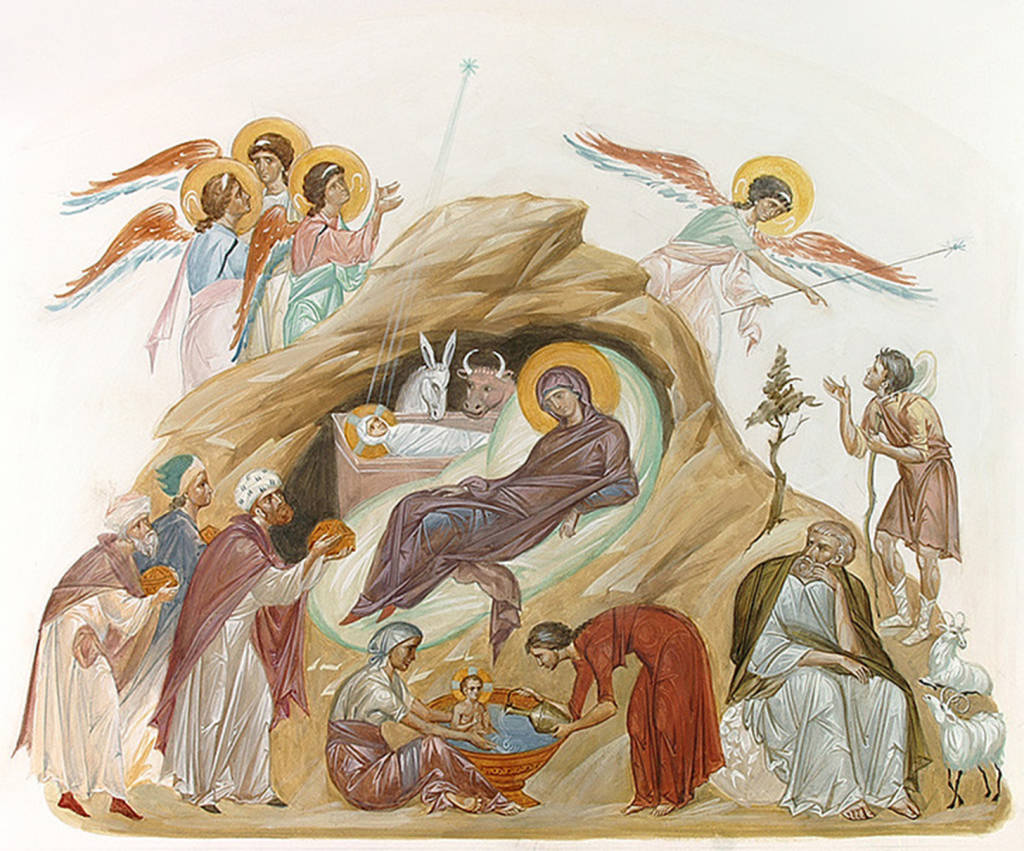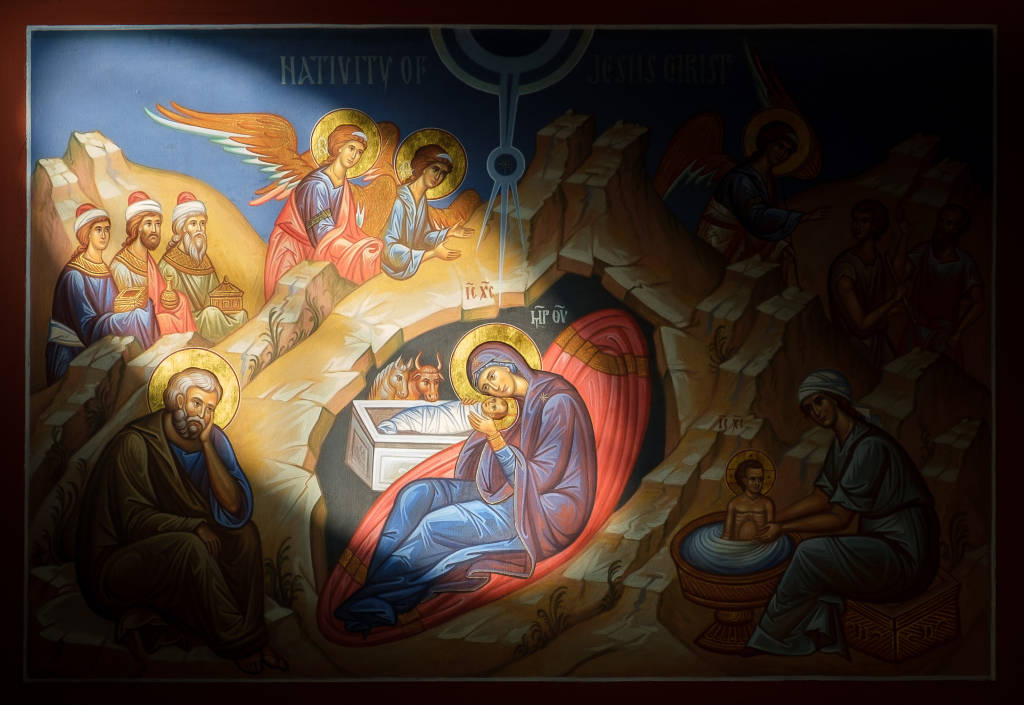
Let us approach the mystery of the incarnation of God as man by looking at a variety of iconographic traditions in the Orthodox world together with some quotes from liturgical texts.
Hymns of Nativity : Troparion
Thy nativity O Christ our God
has shone to the world the light of wisdom,
for by it those who worshipped the stars
were taught by a star to adore Thee, the Sun of Righteousness,
and to know Thee the Orient from on high//
O Lord glory to Thee!
Nativity Hymns : Kontakion
Today Virgin gives birth to the transcendent One,
and the earth offers a cave to the unapproachable One.
Angels with shepherds glorify Him!
The wise men journey with a star!
For unto us the Eternal God is born as a little child!
Russian tradition
This is exemplified by iconographers such as St Andrei Rublev; many modern version follow this pattern.
Pictorially these icons meld together two written sources, namely, the gospel accounts of Luke (chap 2: 4-20) and Matthew (2: 7-12) together with a non-canonical (or apocryphal) source called Proevangelion of James also known as Infancy Gospel of James thought to have been composed in the second century. Taking material from extra-canonical traditions, the Old Testament, and the above gospel accounts this ‘prequel’ text fills in the gaps as it were of Mary’s emergence as the Mother of God (ie her parents, Joachim and the barren Anna, her birth, her rearing in the Temple, and betrothal to an elderly Joseph) and the birth of Jesus in a cave used by peasant farmers, with the aid of local midwives who also witness to Mary’s virginity after the birth.
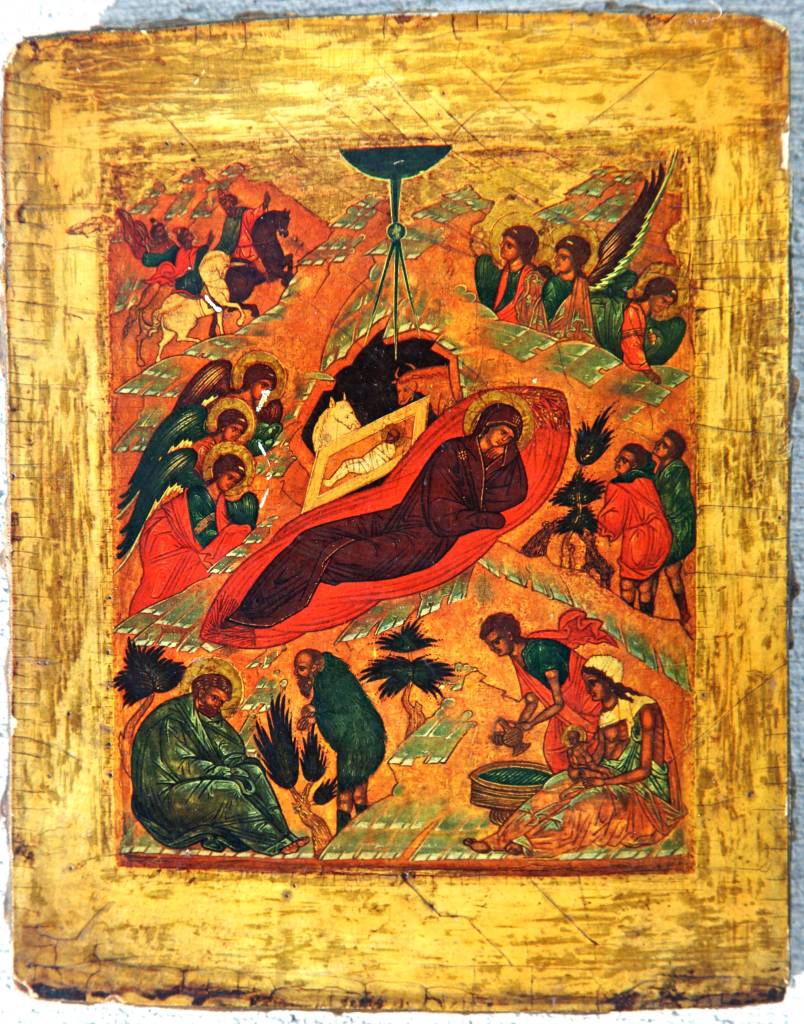
Mediaeval Russian icon
Mary is in centre of the icon reclining on couch having given birth. In a mountainside cave the Christ child lies in beast’s manger on a bed of straw wrapped in swaddling bands. The ox and ass (Isaiah 2) lean over the manger. Three angels are giving glory. At the bottom right we see two midwives, one pouring water into a bath (while testing the temperature with her hand), and one holding the naked child. Above the cave a three pointed ray spreads out from a star (representing the Trinity). At the top right, two angels look across at the three Magi on horseback following the divine star, while one angel leans down to greet the shepherds, with sheep nibbling at the bushes. Finally at the bottom left Joseph sits in contemplative consternation at the birth from the Virgin being tempted to doubt by the demonic looking character with the coat of camel hair.
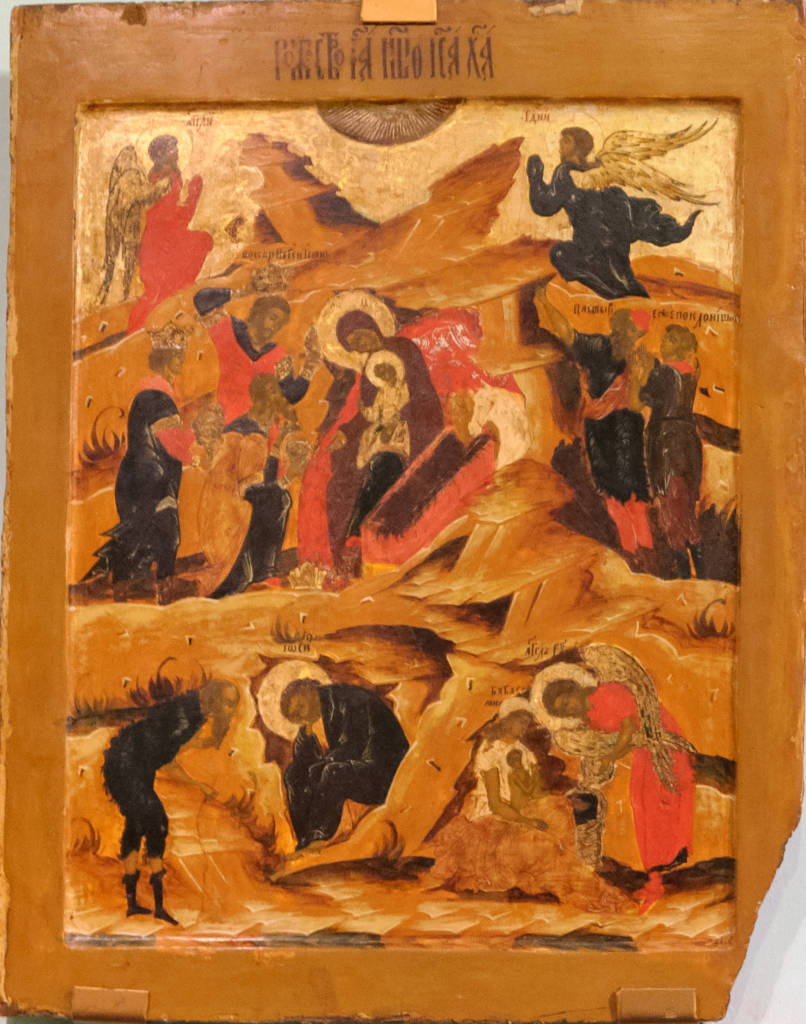
The Rostov icon is a wonderful later variation on this. Mary and the Christ child are still the focus in the central cave, but now sitting on the red couch as it were, Mary has the child on her lap and is showing Him to the attending Magi with open hands, who have evidently dismounted their steeds. From left to right, the first king presents his gift with both hands, the second upper king raises his crown with his left hand and raises his right hand in acknowledgment, and the third king has taken his crown off his head and placed it on the ground and stoops down on one knee to give his gift. What a wonderful encounter! Meanwhile the two shepherds opposite this scene point to the bright rays emanating from the heavens while the angels above them (both of which have names as inscriptions) seem to be singing praises. At the bottom right of the icon one midwife balances the Child on her lap while holding out her hand to test the water being poured from a jar emptied by an angel (!) rather than another midwife. Finally, Joseph — clearly marked by inscription — is fretting in his little cave and here again seems to be tempted by a demonic looking individual.
Hypakoe from Nativity Matins
Heaven brought the first fruits of the Gentiles as a gift for Thee;
A star summoned the wise men to the Babe in the manger.
They were amazed to see neither throne nor sceptre,
But only abject poverty.
What is more humble than a cave?
What is more lowly than swaddling clothes?
Yet the riches of Thy divinity shone through all these.
O Lord, glory to thee.
Byzantine / Greek
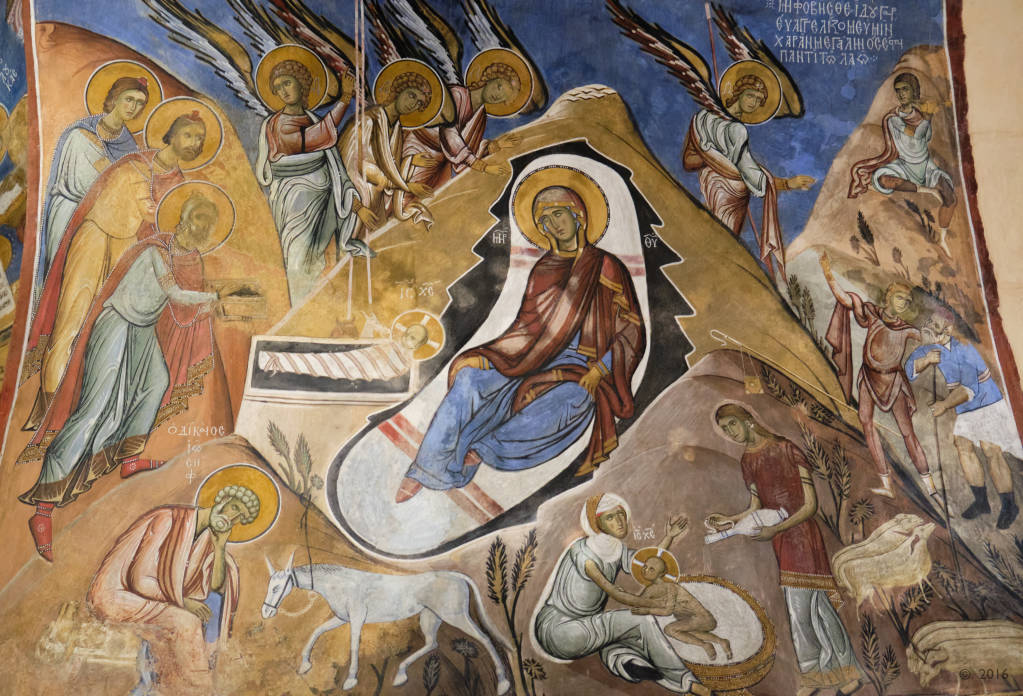
Cypriot (fresco)
Here again we have the Mother of God centrally placed with her and the child as the icon’s focus. Most of the other expected components are present; the three Magi, two groups of angels, shepherds, midwives washing the child and Joseph. But one or two things are noticeably different. While Mary reclines inside the cave as it were, the manger itself with the child is placed outside. And neither is there the ox and ass visible inside the cave. Also missing is the demonic character who apparently tempts Joseph.
Although this is a fresco on a curved wall the mountain containing the cave accentuates the strong diagonals in the composition. The sizes of the figures convey their relative importance; hence the figure of the Mother of God is proportionately larger and the Magi and attending angels are also emphasised.
Personally I find this an extraordinarily beautifully depicted scene, the figures full of warmth and dynamism.
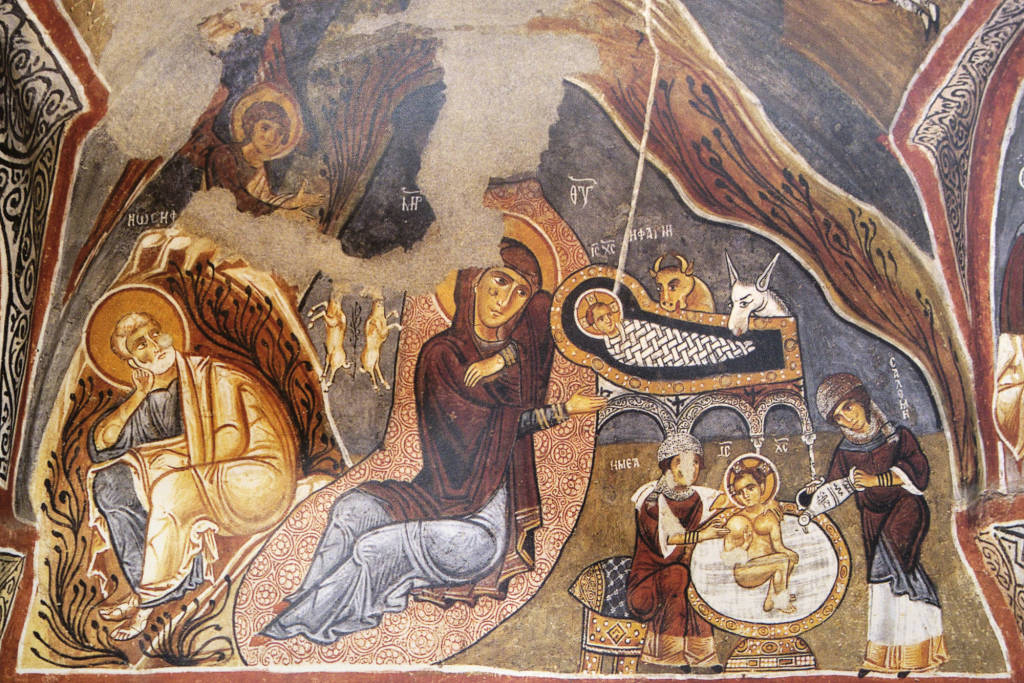
Vespers of Nativity : Lord I Call sticheron
What shall we offer you, O Christ,
Who for our sake has appeared on earth as a man?
Every creature made by you offers you thanks:
The angels offer a hymn; the heavens a star;
the Magi, gifts; the shepherds, their wonder;
the earth, its cave; the wilderness, a manger;
and we offer you a virgin Mother //
O Pre-eternal God, have mercy on us
Kontakion Tone 3
Today the Virgin proceeds to the cave,
Where she will give birth past understanding to the word,
From all eternity.
Rejoice, universe, when the tidings are proclaimed!
Glorify with the angels and shepherds
The One who chose to be manifest as a newborn child//
While remaining the eternal God!
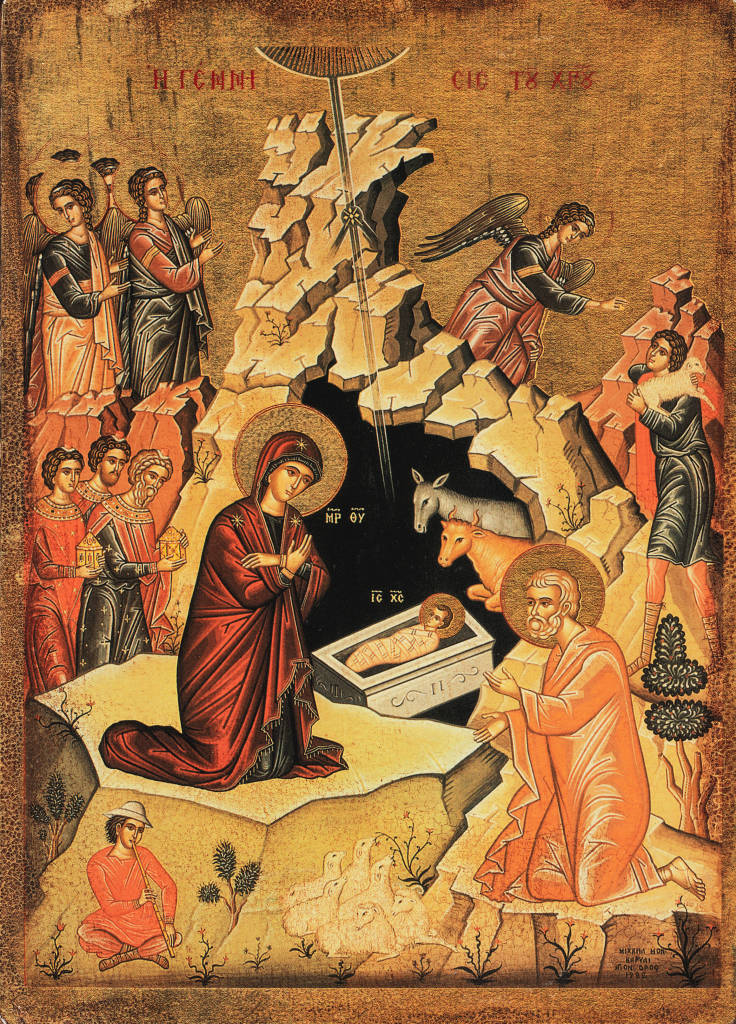
Stavronikita 16thC
This later (1500s) icon from the Stavronikita monastery on Mount Athos has a distinctly different feel to it. The Mother of God is not reclining on her birthing bed, rather, she is kneeling with arms crossed on a flat rock (as though for communion?). Meanwhile Joseph is no longer a peripheral figure; he is now also kneeling (rather than sitting) on a lower rock with outstretched arms and open palm of acceptance. The major diagonal now travels through Joseph, the Child, Mary and the Magi/angels. Arguably this can be considered a western European influence where Joseph’s role is given a deal more weight in the Nativity narrative. Moreover, the absence of the midwives and the washing of the newborn is also a departure from the traditional iconographic depiction.
The Christ child is swaddled in a way resembling a funerary winding-sheet and the manger bears an increasing resemblance to a coffin. There He lies in the dark cave of unredeemed humanity waiting for His time to reveal Himself.
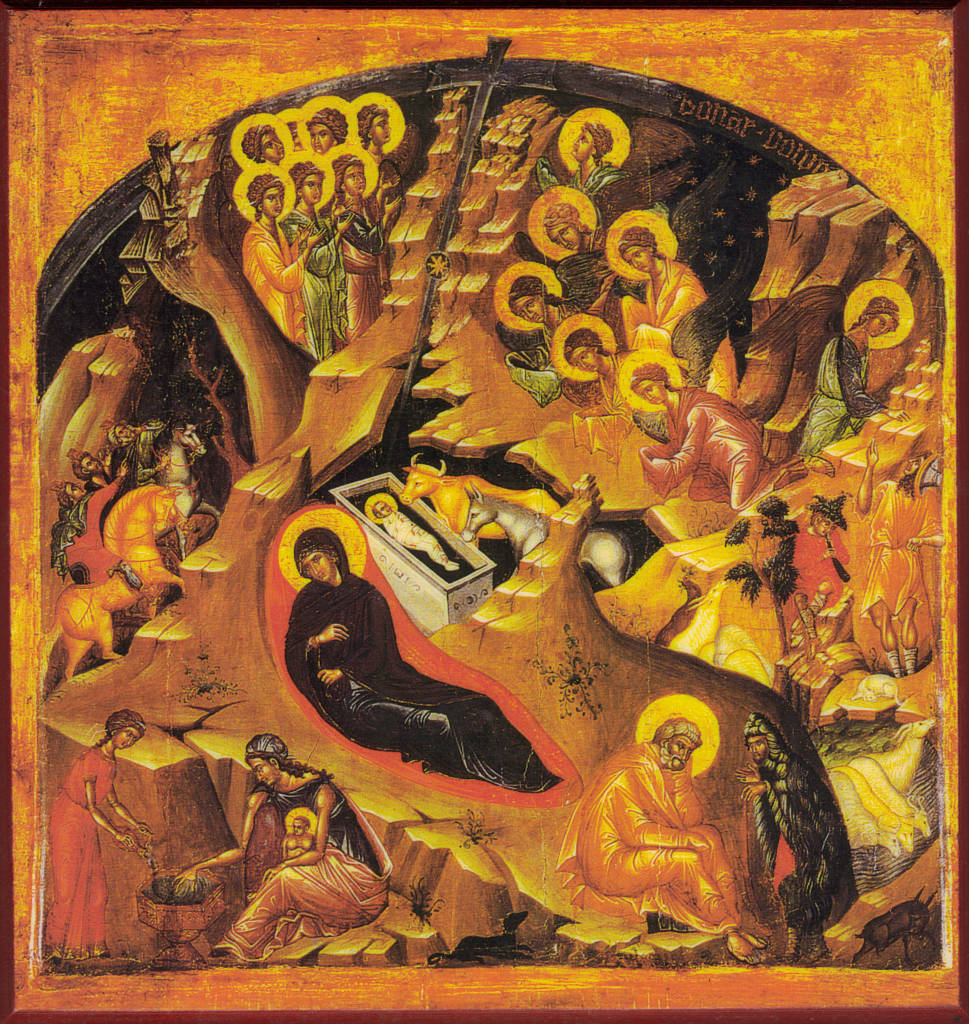
15thC Greek
This is recognizably similar to the Russian style we saw at the top of the page with a couple of exceptions. The positions of Joseph (with halo) and the midwives is inverted — Joseph on the right, & the bathing of the Child on the left. The Virgin on her red birthing mat is outside the cave and leans towards the midwives. The Magi struggle uphill on their horses while the group of angels ignore them, instead greeting with outstretched arms the descent of the Holy Spirit accompanied by the star. The beam of light bisects the rocks into the cave in a most unusual manner. Ox and ass gaze at the Child in the manager. A group of five other angels (so many of them!) kneel before the Christ child with hands covered by folds of their garments in token of their adoration. A single angel appears to the shepherds one of whom is playing a pipe. Sheep frolic and nibble a bush.
Introduction to Commentary
The iconography of the Nativity of Christ is derived from the gospels of Matthew & Luke, but most influenced by the ‘non-canonical’ text Protevangelion of James. This “infancy gospel” dating from 140-170 A.D. combines and harmonises the accounts in the synoptic gospels with very early “extracanonical traditions“; for example, the birth in a cave was a tradition known to the second century Justin Martyr.
[For theological exposition see A wealth of theology in the Nativity icon ]
- Protevangelion of James
- 12:13 Joseph finds a cave for Mary to give birth in.
- 14:1-16 Joseph finds midwife who observes the birth. Midwife meets another woman Salome outside the cave and tells her about the Virgin birth.
- 14: 17-31 Salome disbelieves and after testing for Mary’s virginity her hand withers. After supplicating God and touching the Child she is healed and worships Him. Then she is told by a voice [from heaven] to keep quiet about what she has seen and she and the midwife leave the cave and Mary.
- Luke 2:19
- But Mary kept all these things, and pondered them in her heart.
Commentary
- The Virgin is usually at the center of the icon on a red mat (indicative of a birthing bed – cf Nativity of the Virgin) which can be located inside or immediately outside the darkness of the cave.
- The Virgin always looks pensive and in most icons does not look directly at the Child. In the Russian traditional format she is commonly actually turned away from the Child. I suspect that this is a reflection of her wonderment at what has just happened, cf “But Mary kept all these things, and pondered them in her heart.” Luke 2:19.
- The manger is always either set in the darkness of the cave or its interior is black. This might bring to mind the darkness of unredeemed humanity.
- Most icons have the washing of the Child by the midwife (named “Imea” in the Kappadocian fresco) and with Salome pouring the water into the basin. This is often taken as a prototype of future Baptism of Christ. However, the actual washing of the Child is not mentioned in any of the texts, but a similar scene is always depicted in the icon of the Nativity of the Virgin.
- Joseph is seated with his hand on his chin as though in distress; personally I wonder whether he is wondering how he is going to cope, and what he is going to say to others.
- Earlier Byzantine iconography (as fresco in church) omit the demonic character supposedly tempting Joseph.
- However, Russian iconography usually includes this scene which not attested to in the Protevangelion.
- More recent Russian iconographers (Dimitry Scholnik, Anatoly Aleshin) omit the devil figure.
- Angels wonder at the star or point it out to the Magi, greet the shepherds and worship the Child.
- Magi or ‘wise men from the East’, always three in number, bring gifts – this is strictly an anachronism since in the gospel accounts this occurred later. They may or may not be mounted on horses (but never camels).
- Shepherds are usually present with one or more sheep (or furry animals approximating to the same). Often one of them plays on a pipe. An Angel usually greets them with an outstretched arm.
